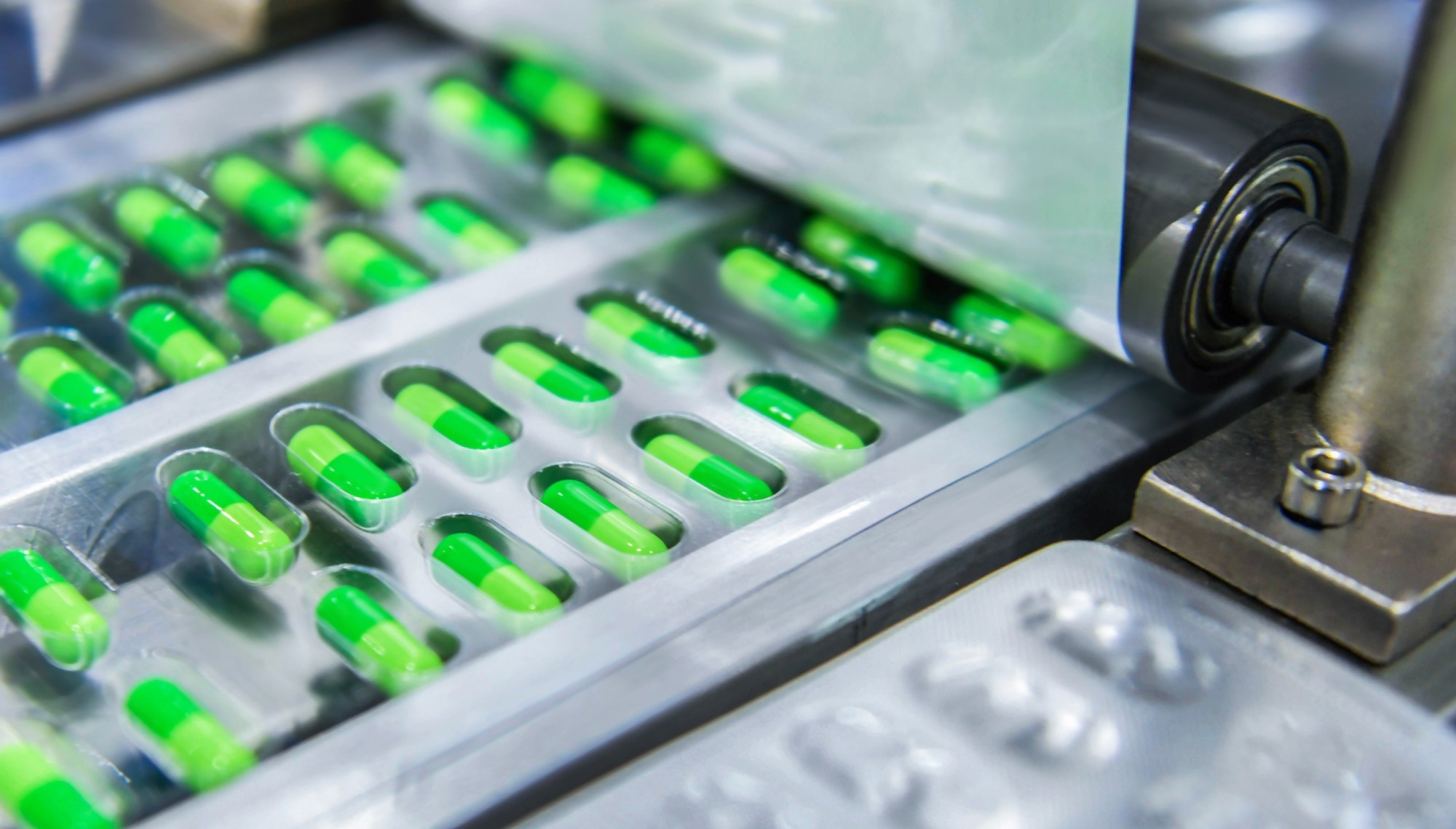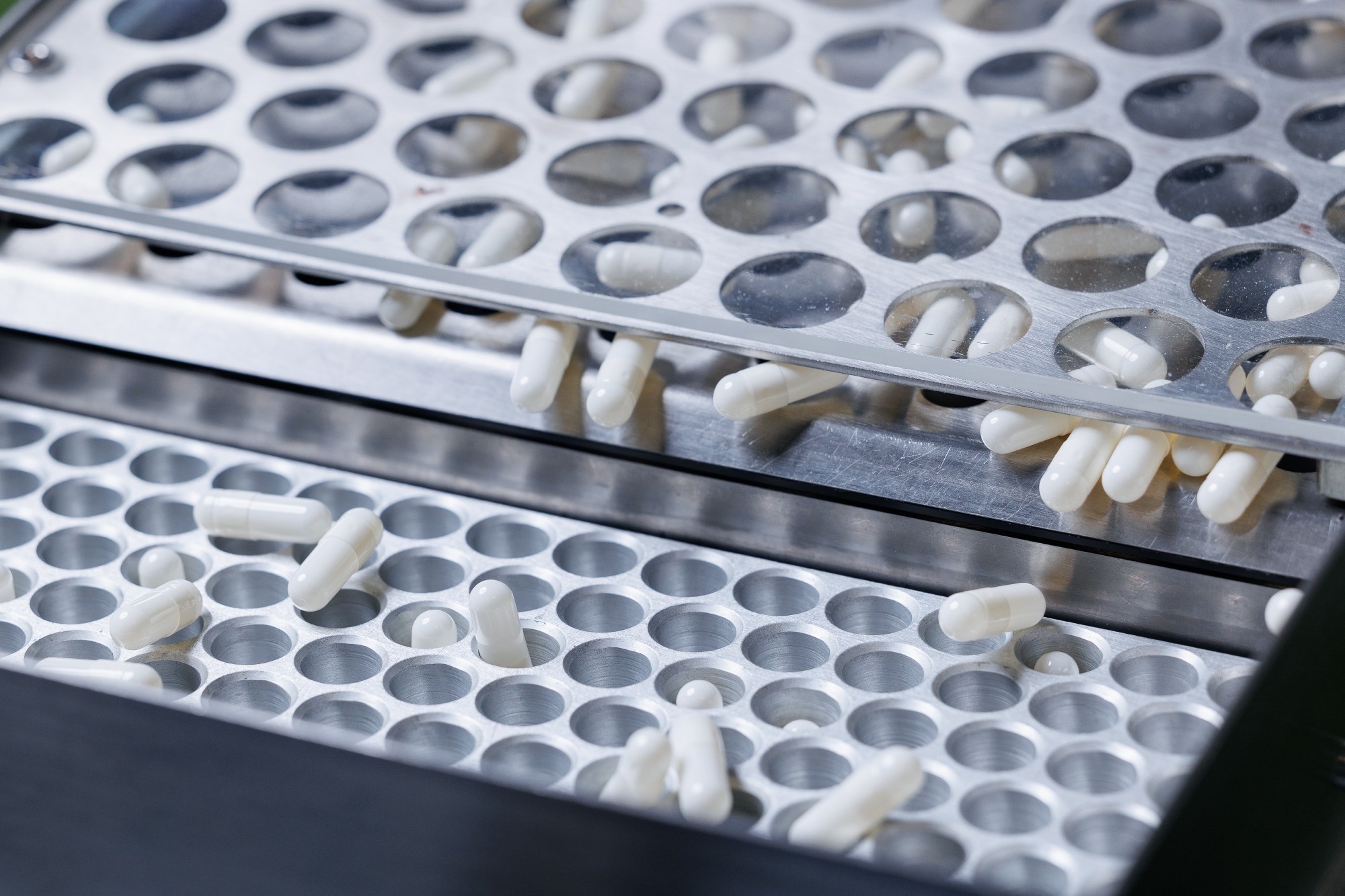The uses of rheology are spreading beyond their traditional scope in mechanical engineering. Powder tribology, in particular, is increasingly being used in pharmaceutical formulation. How do powders flow, stick, and compact? This science can be used to perfect tablet manufacturing—here's why.1
 Image Credit: i viewfinder/Shutterstock.com
Image Credit: i viewfinder/Shutterstock.com
Powder tribology offers a way to understand particle interactions at their contact points, capturing both interparticle friction and surface adhesion. These interactions have been studied in mechanical systems, but are revealing in pharmaceutical powder behaviour too, from flow to compaction. Understanding these properties improves manufacturability, product quality, and dosage form performance.1,2
Most medicines that are taken in tablet form are produced from a powder. While bulk properties of these materials, such as flowability and compressibility, have been studied for decades, recent research has renewed focus on the tribological behaviours that govern particle-level interactions.2
Fundamentals of Powder Tribology
In a powdered material, each particle is a miniature solid body with a unique shape, surface chemistry, and topography. When powders are set in motion or subjected to stress, the points of contact between particles generate both frictional resistance and adhesion forces. These interactions at the surface level determine whether powders flow smoothly or consolidate into a coherent mass, or even resist compaction altogether.3
Interparticle friction occurs when surface roughness causes individual particles to drag against each other. Rougher, more angular particles often generate higher friction coefficients, limiting their flow. Adhesion forces, like van der Waals attractions and electrostatic charges, add further complexity to particle cohesion. These two behaviours govern the balance between flowability and cohesion, critical qualities in the design and manufacture of tablets.3
Tribology provides a useful framework for describing these interactions by focusing on three metrics: the coefficient of friction, which is the resistance to sliding between surfaces; wear, which is the gradual loss or rearrangement of material during repeated contact; and lubrication, which refers to the use of a material that reduces direct contact and lowers friction.1, 3
Although originally defined in the context of mechanical components, these concepts naturally transfer to pharmaceutical powders. Effective formulations require powders with controlled friction and responsiveness to lubrication.
Tribological Behaviour in Pharmaceutical Manufacturing
 Image Credit: Parilov/Shutterstock.com
Image Credit: Parilov/Shutterstock.com
Powder Flow and Handling
Poor flowability is one of the key concerns in pharmaceutical processing. High interparticle friction and strong cohesive forces can lead to flow interruptions, segregation, and inconsistent die filling. Tribological insights help explain why some excipients, like microcrystalline cellulose, flow poorly, whereas more spherical materials, such as spray-dried lactose, have better flow. Such measurements can also illustrate the role of glidants like colloidal silica, which modify surface interactions and reduce friction between particles.4
Compaction and Tablet Formation
Tribology is just as important during powder compaction. When powders are compressed, particles must rearrange around one another to form a coherent, compact form. High interparticle friction can impede rearrangement, requiring higher compaction forces, while insufficient adhesion may compromise tablet strength.
Tablet properties like hardness and disintegration time depend on the frictional resistance and surface bonding of the powders involved. Recent advances in nanoindentation and surface force mapping, as reviewed by Sadeghi et al., have shown how particle-level characteristics such as hardness, elasticity, and surface energy can influence bulk compaction performance. These tools can bridge micro-scale mechanics and finished tablet quality.5,6
Lubrication and Ejection
Lubricants, particularly magnesium stearate, are essential in tablet manufacturing. Their tribological function is to form a thin layer at the interface of the powder and the die wall, reducing friction during compaction and enabling smooth ejection.
However, excessive lubrication can weaken interparticle bonding and slow dissolution. Tribology provides a mechanistic understanding of this trade-off, highlighting the importance of optimizing lubricant concentration and mixing conditions.5
Insights from Pharmaceutical Tribology Research
Tribology is already well established in biomedical and food sciences. For instance, recent studies by Nayak et al. on nickel-free stainless-steel implants manufactured by powder bed fusion evaluated coefficients of friction under dry and lubricated conditions, demonstrating how surface hardness and lubrication govern wear and performance. While focused on medical devices, these findings clearly illustrate that tribological properties determine material durability and functionality.7
Similarly, tribological testing has been applied to oral liquid pharmaceuticals, particularly pediatric suspensions. Using rheometer-based tribological setups, researchers have shown how viscosity, grittiness, and particle size can affect the coefficient of friction, correlating with mouthfeel and patient acceptability. These approaches, adapted from food science, further highlight how tribology can predict sensory perception, which is an important factor in patient-centric drug design.2
Download your PDF now!
Emerging Role of Tribological Testing in Formulation Optimization
Traditionally, powder behaviour in pharmaceuticals has been evaluated through bulk characterization methods such as angle of repose, Hausner ratio, and shear cell analysis. These tests are useful, but they only provide a limited mechanistic view of powder behaviour at the particle level. Tribological testing directly probes the contact mechanics between particles, allowing a more fleshed-out understanding of powder performance.8
For instance, microtribometers can measure the sliding resistance between individual particles or between particles and metal surfaces, effectively simulating die-wall interactions. Nanoindentation techniques allow the quantification of particle hardness and elastic modulus, determining deformation and bonding during compaction. Similarly, rheometer-based tribology, originally developed for oral suspensions, can characterize lubrication regimes and identify transitions from boundary to hydrodynamic lubrication.9
Integrating tribological data into formulation workflows has a direct and practical impact on tablet design and performance. It allows manufacturers to optimize excipient selection by choosing fillers and binders with favourable frictional and adhesion properties, ensuring powders flow and compact effectively.8
Powder tribology also enables greater precision of lubrication, where the type and concentration of lubricant can be adjusted to achieve a balance between smooth manufacturability and reliable drug release. Additionally, tribological measurements help predict potential manufacturability issues such as sticking, capping, or lamination before they arise in large-scale production.8
Future Perspectives
Integrating powder tribology with Process Analytical Technology (PAT) is a promising new avenue in pharmaceutical manufacturing, where in-line tribological sensors could monitor die-wall friction during tableting and enable real-time quality control.8
Advances in computational modelling are also having an impact, with discrete element modelling (DEM) increasingly coupled with tribological parameters to provide more accurate simulations of powder flow and compaction.
Beyond manufacturing efficiency, powder tribology also supports patient-centric innovation: as demonstrated in pediatric suspension studies, tribological insights can guide the development of dosage forms that optimize sensory acceptability and manufacturability.
Finally, tribology has implications for sustainable pharmaceutical production. Understanding friction and wear can inform formulations to reduce tooling degradation and minimize material waste.
References and Further Readings
- Rapoport, L., et al., Superior Tribological Properties of Powder Materials with Solid Lubricant Nanoparticles. Wear 2003, 255, 794-800.
- Lee, H. J. et al., A Method for the Tribological Assessment of Oral Pharmaceutical Liquids. Drug Development and Industrial Pharmacy 2022, 48, 198-210.
- Opia, A. C.; Hamid, M. K. A.; Johnson, C. A.; Rahim, A. B.; Abdulrahman, M. B., Nano-Particles Additives as a Promising Trend in Tribology: A Review on Their Fundamentals and Mechanisms on Friction and Wear Reduction. 2021.
- Stoica, M.; Petrescu, M. G.; Ripeanu, R. G.; Laudacescu, E.; Tanase, M., Experimental Research on the Tribological Behavior of Plastic Materials with Friction Properties, with Applications to Manipulators in the Pharmaceutical Industry. Coatings (2079-6412) 2025, 15.
- Orgeldinger, C.; Seynstahl, A.; Rosnitschek, T.; Tremmel, S., Surface Properties and Tribological Behavior of Additively Manufactured Components: A Systematic Review. Lubricants 2023, 11, 257.
- Sadeghi, B.; Cavaliere, P.; Shabani, A.; Pruncu, C. I.; Lamberti, L., Nano-Scale Wear: A Critical Review on Its Measuring Methods and Parameters Affecting Nano-Tribology. Proceedings of the Institution of Mechanical Engineers, Part J: Journal of Engineering Tribology 2024, 238, 125-155.
- Nayak, C. et al., Tribological Behavior and Biocompatibility of Novel Nickel-Free Stainless Steel Manufactured Via Laser Powder Bed Fusion for Biomedical Applications. Materials & Design 2024, 242, 113013.
- Johns-Rahnejat, P. M.; Rahmani, R.; Rahnejat, H., Current and Future Trends in Tribological Research. Lubricants 2023, 11, 391.
- Lofaj, F.; Ferdinandy, M.; Cempura, G.; Dusza, J., Nanoindentation, AFM and Tribological Properties of Thin Nc-Wc/Ac Coatings. Journal of the European Ceramic Society 2012, 32, 2043-2051.
Disclaimer: The views expressed here are those of the author expressed in their private capacity and do not necessarily represent the views of AZoM.com Limited T/A AZoNetwork the owner and operator of this website. This disclaimer forms part of the Terms and conditions of use of this website.